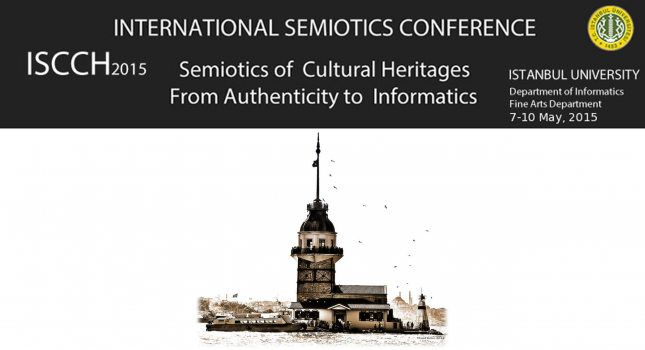
CFP: Semiotics of Cultural Heritages, From Authenticity to Informatics -7-10 May 2015 – Istanbul University
Semiotics of Cultural Heritages, From Authenticity to Informatics.
7-10 May 2015
İstanbul University
Department of Informatics & Fine Arts Department
Semiotics of Cultural Heritages is an international research project founded by Professor Eero Tarasti two years ago. It is largely based upon his theory of existential semiotics.
The projects has now over 80 members, scholars from all over the world. It has already convened a.o. in Imatra, Kaunas, Rome and Sofia.
The Istanbul symposium starts from the following arguments. It is open for anyone interested in the topics.
All can and have to agree that our global world has undergone enormous changes and crises in many aspects. There is a hypothesis that societies undergo three phases: first: archaic in which people and communities live still nature-bound life with cyclical time and with mythological worldview and traditions; second: socio-semiotic which was the avenue chosen by the Western world in the emergence of modernity, leading to certain stratified social structures, class, industrialization, democratic institutions, enlightenment, humanistic Bildung idea, in one word a certain historic development. The third one is techno-semiotic, the society under modern electronic and computer technology, with internet, increasing communication, the ‘extase’ of communication, changing radically the previous structures of social organization.
If this idea is taken seriously, it certainly means that we should not straight ahead reject the cultural traditions and achievements of the past. Some of them should be preserved which means that we consider some of them to represent such values which are worth to be believed in still in our techno-period and even to serve as a kind of ‘lived-in’ models as Claude Lévi-Strauss once said.
That part of our social practices which we find worthwhile to be maintained we can call a cultural heritage.
Such a heritage can be as to its size and scale of whatsoever nature: it can be an entire living form, culture, it can be a nation, it can be a language almost disappearing (like there can be languages spoken only by one or two persons), it can be a certain behaviour, rite, manner, myth, value, object, genre, fest, any type of material or spiritual culture of any quantity. So any sign and particularly its signified, the idea, or value which it represents.
This Congress in the sense invites scholars that should each select;
Such a cultural heritage to which he /she feels to be close, in which he/she is competent, and which he/she considers of value to be preserved. Most often in our techno-semiotic phase such traditions are under constant threat of vanishing, getting destroyed or simply forgotten and ignored by our own time and particularly by what we think is future.
However, it can also be simultaneously so that our electronic techno-time can provide us tools hitherto unknown and efficient for its preservation, restoration and renewal.
Situation is hence not only ‘in the search for time passed’ (A la recherché du temps perdu à la Marcel Proust) but rather making the chosen heritage a part of living tradition in future.
For any such type of conduct or material or spiritual thing as cultural heritage we can also distinguish among four modes of ‘being’ so to say, to borrow from the theory of existential semiotics, such as it is presented in the recent article in the Oxford Dictionary of Cultural Psychology (ed. by Jaan Valsiner, see Tarasti 2012),
body: how single individuals physically carry the heritage, which kind of corporeal activities it presupposes to be functional
identity: which kind of personality or ‘habit’ (Ch.S. Peirce) is presumed to be enjoying the heritage, which kind of stable or less stable identity is necessary for its living and survival
social practice: how the heritage is shared by members of a certain community, how it is enacted by given social roles within it, how it exists as a routine , almost unnoticeable practice and tradition, and how it is supported by discourse(s) around it, how it is integrated as a part of social life, which profession, which groups exercise it
values, norms: which kind of more abstract value and norm system it is manifesting, from which kind of epistemic ideas it is originating, is it in harmony or in conflict with dominant belief systems of the society
Conference includes theoretical discussions as well as visual performances, workshops and poster presentations.
Selected papers will be published by Semiotica and Social Semiotics. All accepted papers, after peer review, will be published in the digital Proceedings of the Conference. Additionally, selected papers on the conference topics will be published in print. Other index publication opportunities will be announced.
The subtopics of the conference will cover but not limited to:
Cultural Heritages in Dialogue
Renewing Cultural Heritages
Cultural Heritages as represantations of Values
Cultural Heritages and their Communities
Body Person and Values in Cultural Heritages
Cultural Heritages as sign systems and Processes
Cultural Heritages Lost
Cultural Heritages based on Istanbul
IMPORTANT DATES
28 February 2015 Deadline for sending abstracts
10 March 2015 Abstract approval notification

Leave a Reply
You must be logged in to post a comment.